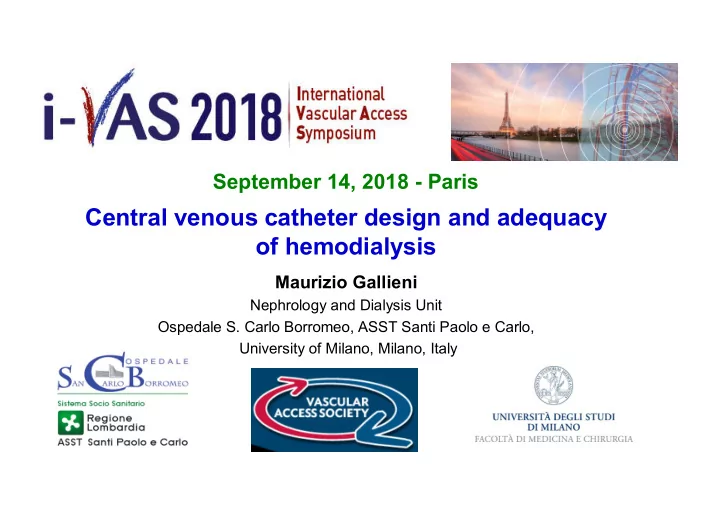

September 14, 2018 - Paris Central venous catheter design and adequacy of hemodialysis Maurizio Gallieni Nephrology and Dialysis Unit Ospedale S. Carlo Borromeo, ASST Santi Paolo e Carlo, University of Milano, Milano, Italy
Natalie Cole holds a Grammy February 8, 2009 Photo: Macon/Getty
May 2009 31 Dec 2015
Characteristics of the ideal dialysis catheter • Easy to insert and remove • Kinking resistant material • Free of infection • Free of fibrin sheath (invisible to body) • Does not cause venous thrombosis and/or stenosis • Delivers high blood flow (> 400 ml/min), reliably • No recirculation • Durable • Comfortable and acceptable to the patient • Inexpensive Modified from: Trerotola SO. Radiology 2000; 215:651-658
Catheter Diameter and Performance Poiseuille’s law Changes in the radius (and therefore in diameter) potently influence blood flow (Q) Increasing the diameter from 2.0 to 2.1 mm will increase blood flow by 20% 20% diameter increase: 2X increase in flow 50% diameter increase: 5X increase in flow 100% diameter increase:16X increase in flow If CVC length is doubled, flow will be reduced by 50%
Non-tunnelled vs tunnelled catheters (acute vs chronic) Cuff Pre-curved Split tip
Acute dialysis catheter design Pre-curved Internal jugular vein Internal jugular vein Femoral (and subclavian) vein
Valved introducer vs over the wire insertion Mojibian H. J Vasc Access 2010; 11: 342-45
Retrograde vs. antegrade tunneling Retrograde tunneling and catheter
Retrograde vs. antegrade tunneling Antegrade tunneling
Tunneled catheter design Single lumen vs double lumen catheters
Catheter tip design Side holes versus no side holes
Catheter tip design Split tip, step tip, symmetric tip
Self flushing functional tip Spector J Vasc Interv Radiol 2008; The symmetric tip design theoretically allows flow of blood through the catheter tip between treatments. The blood enters through the side slots and exits through the tip. This flow of blood might reduce thrombus formation on the catheter tip.
Catheter tip design Pre-shaped, reversed ports
Review of the general features of CVCs, including differences between tunneled and nontunneled CVCs, materials and their compatibility with lock solutions, the implications of straight versus precurved design in nontunneled CVCs, lumen and tip features with their clinical implications, catheter coatings and their effect on infection and thrombosis.
• The PermCath TM and Tesio TM provide blood flow and reliability superior to the VasCath TM . • All three catheters are capable of providing adequate haemodialysis although large patients will need extended treatment times. • Blood flow is limited in all catheters by inflow, as evidenced by negative arterial pressure. • All catheters had acceptable recirculation. • AV access is superior in terms of blood flow and reliability to all tested catheters. NDT 1998; 13: 745-9
Kidney International, 2002; 62: 282–289 • Prospective, randomized trial comparing the Ash- Split (MedComp) and Opti-Flow step tip (Bard Access Systems) hemodialysis catheters. • The purpose was to compare the function and complications of the two catheters
Trerotola S et al. Kidney International, 2002; 62: 282–289 RESULTS • 132 patients were enrolled in the trial. • Maximal blood flows were 414 mL/min for the split tip and 433 mL/min for the step tip (P = 0.03) • Recirculation was significantly higher with the step tip catheter (7.9% vs. 1.6% at 400 ml/min). • Total late complications were lower the split tip group (25% vs 42.6%, P = 0.04), and catheter survival (figure next slide) was significantly higher in the split tip group (P 0.02).
+ +++ + + + + + + + + + + Split tip + + + + + + + + + + + + + ++ +++ + + Step tip + CVC survival - Log-rank test P = 0.022 Trerotola S et al. Kidney International, 2002; 62: 282–289
Case-control study JVIR 2008
Primary assisted patency rates – Overall results Kakkos SK et al. JVIR 2008
Am J Kidney Dis. 2014; 64:902-908. 302 CVCs in 239 patients Palindrome Symmetric Tip HemoStar step tip
Van der Meersch H et al. AJKD 2014; 64:902-908
Van der Meersch H et al. AJKD 2014; 64:902-908
Van der Meersch H et al. AJKD 2014; 64:902-908
CONCLUSIONS • Urokinase use was lower (-42%) and blood flow rates were higher (+9%) for the Palindrome catheter • Catheter survival was excellent for both catheters (71.3% for Palindrome and 76.4% for HemoStar at 24 months) • Removal for thrombosis and infection were very low compared with data in the literature and were similar for both catheters. Van der Meersch H et al. AJKD 2014; 64:902-908
Prospective, observational cohort study comparing the function and complication rates of tunneled CVCs in dialysis patients within a follow-up period of 24 months. 1. Shotgun (SG) modified step-tip 2. Split-tip (ST)
Thrombolytic therapy with alteplase was used significantly more often in the Split-tip (ST) group (29%) than in the Step-tip (SG) group (16%). The CVC replacement rate was significantly higher in the ST group (19.3%) compared with the SG group (8.7%).
Observational study in 73 patients (46 self-centering vs 27 slpit-tip). • Improved patency with the self- self-centering centering catheter versus the split-tip catheter. split-tip • Mean blood flow at 6 mo: 388 vs 352 ml/min (p<0.01).
Observational study in 46 patients. • Mean blood flow 333-392 ml/min. • Kt/V > 1.5 • Two infections: 0.7/1000 CVC days
CONCLUSIONS • Catheter design does have an impact on performance • More design improvements are desirable, to move towards the “perfect” CVC, invisible to the body (no thrombosis), with no or very low infections, patient friendly. • Such a CVC could solve one of the major obstacles to the development of home hemodialysis
Recommend
More recommend